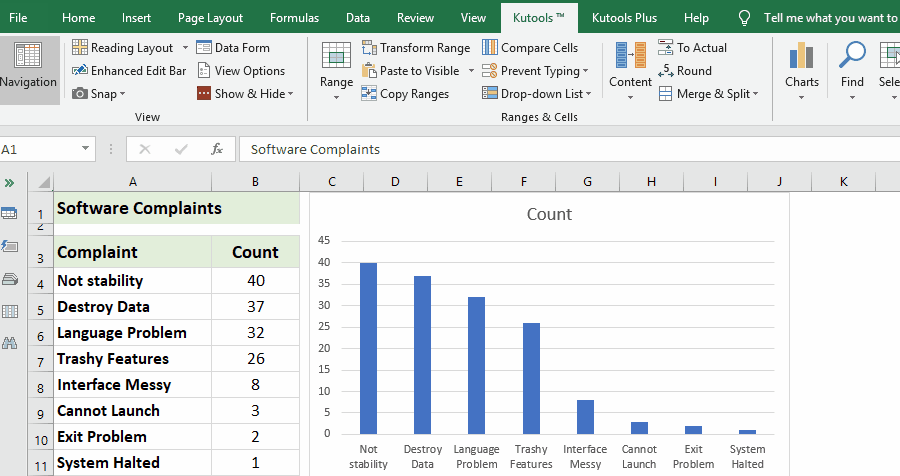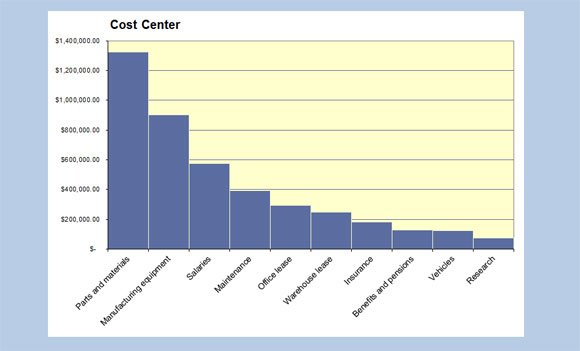

- #Pareto chart in excel 2013 using data analysis software
- #Pareto chart in excel 2013 using data analysis code
Learn use of Pareto Charts.Learn Pareto Analysis in 8 easy steps. Need involvement of related quality control team and Easy steps to create pareto diagram in Excel 2016. You can use the mouse to do so from the data tab. Cumulative values should not be a part of the chart. It is always good to capture the cumulative percentage of the frequencies or data value and sort the data values in descending order. Chapter 43 Summarizing data by using histograms and Pareto charts Questions answered in this chapter: People often say that a picture is worth a thousand words. In laymen terms, Pareto Analysis is also called as 80/20 principle. To sort data, select the data range (don’t select Total Cell) and hit ALT, A, S, S one by one (keyboard shortcut for sorting). Things to Remember About Pareto Analysis in Excel. This Pareto Analysis Excel Add-In brings the benefits from automation in one-click: convenience, time savings and reliability. A Pareto Analysis is a simple yet powerful process derived from the 20/80 rule that allows you to focus on what really matters. To display recommended charts, select the entire data range you want to chart, click the Quick Analysis button, and then click Charts to display the types of charts that Excel recommends. Step 1: Sort data in descending order in excel. Time and money are limited resources which can be easily optimized with a Pareto Analysis. If you can identify all reasons behind aĭefect, you can easily work to reduce or remove it by taking some correctiveĪction against defects. With Excel 2013, you can create charts quickly by using the Quick Analysis Lens, which displays recommended charts to summarize your data. Ishikawa diagram which identifies all root possible causes behind a problem or Arrange the defect codes in descending order of numerical Occurrence. You’ll need three columns for now, one as a counter, one with your defect codes.
#Pareto chart in excel 2013 using data analysis code
Fishbone diagram is also called ‘Cause and effect diagram’ or Pareto Chart in Excel 2013 How To’sday Step One : Defect Code Identification. The fishbone is easy to construct and invites interactive participation. It is sometimes referred to as the “Ishikawa diagram” because kaoru Ishikawa developed it and the “fishbone diagram” because the complete diagram resembles a fish skeleton. Finally, the Pareto chart will look like. In Axis Options, select the Maximum from Auto to fixed and enter a value 100 manually and close the format axis window. Cause and effect analysis is a tool for analyzing and illustrating a process by showing the main causes and sub-causes leading to a defect. Click on the right-hand axis and select format axis, then under the axis option tab, select maximum to set it to be fixed, and set the value to 100. Open a blank worksheet and save as “Pareto.” In the sheet, create a table with a column of items and the frequency of their occurrence (Figure 1).There are must be many potential reasons, or causes, which ultimately lead to creating a defect. (Note: Excel 2003 was used to create the graphs, but it should not be much of a problem to replicate this in other versions of Excel.) 1. Once practitioners are comfortable with all the steps, they may wish to modify the prototype further.

Practitioners need not be Excel wizards the template is designed so that they may directly input the formulas provided.

This simple chart can be created in six stages. Click Insert > Insert Statistic Chart > Pareto. Prepare the source data in Excel, and select the source data. If you are using Excel 2016, 2019, or 365, you can easily create a pareto chart as follows: 1. By following the steps described here, practitioners can create a Pareto chart that can be updated with a click of a button, provided they input the data labels and their respective frequencies. Create a pareto chart in Excel 2016, 2019, or 365. A dynamic Pareto chart template can be a practical aid to practitioners in this situation.
#Pareto chart in excel 2013 using data analysis software
While working in environments where costly software is not easily accessible across the organization, an Excel-based Pareto chart can come in handy.


 0 kommentar(er)
0 kommentar(er)
